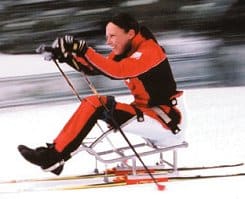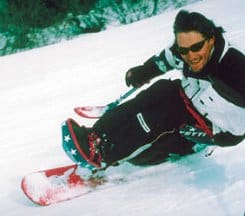
By Lori Batcheller

In 1982, while on a Coast Guard mission in Alaska’s Aleutian Islands, 21-year-old Chris Devlin-Young and his crewmates were attempting to find a runway in the fog. Instead, their plane crashed into a mountain, and Devlin-Young emerged with an incomplete T12 spinal cord injury. Several years earlier another 21-year-old, Candace Cable, injured her spinal cord at the T11-12, L1 level in an automobile accident that forced a detour to Rancho Los Amigos for rehabilitation. Now, in the winter of 2002, Devlin-Young and Cable, both seasoned veterans, are among 500 disabled athletes from 36 countries competing for gold, silver, and bronze medals at the VIII Paralympic Winter Games in Salt Lake City, Utah.
About 200 athletes will use adaptive equipment that allows them to compete in winter sports while sitting down. As a member of the United States Disabled Ski Team, Chris Devlin-Young will compete in the four alpine events –slalom, giant slalom, super G, and downhill, skiing at speeds up to 65 miles per hour. Teammate Candace Cable competes on the Nordic team in the biathlon and cross-country events.
Devlin-Young says now he lives a better lifestyle overall than before his injury. But getting to where he is today–the only team member to win medals as both a stand-up and sit-down skier and one of the only USDST members to have retired and made a comeback–was not an easy journey.
For two years following his injury he lived at home and did as little as possible, sleeping, eating, driving around, keeping to himself, and making life miserable for his parents. He felt like “half a man” and questioned why he was the one so severely injured. But one day while hogging the TV remote in the VA Palo Alto Health Care Center hospital lounge, a chance meeting with a recreational therapist changed his life.
The therapist invited him to go skiing through a new program sponsored by the Department of Veterans Affairs and the Disabled American Veterans. Although Devlin-Young had never skied, he decided to give it a try. On his first run in a sit-ski with the wind blowing through his hair, he was hooked. Looking back, he considers that moment as monumental as the day he became paralyzed.
Since then, skiing has been a major part of his life. He soon realized that with the assistance of leg braces and outriggers, he could compete with other disabled stand-up skiers and, after two years training full-time at Winter Park, Colo., he made the USDST. Despite cautionary advice from his doctors, Chris competed in the stand-up category for another eight years. But at the 1994 Paralympic Games in Norway his knees finally gave out. Doctors drained his knees daily, enabling him to compete and win gold in the slalom event, but afterward, Chris could no longer stand with braces.
Undeterred, he learned to monoski and set his sights on again making the team. He also learned that he had been crazy to stand up and ski in the first place. By 1996 he had competed for another two years as a sit-skier before feeling drawn to pursue other avenues besides racing, including snowboarding and synchronized skiing.
In 1997, after being invited to compete in the U.S. Extreme Snowboarding Championships in Crested Butte, Colo., Devlin-Young recognized a need for adaptive equipment for snowboarders. He developed the first mono-snowboard, the Trench Digger 5000. Seeing a need to train disabled ski racers on the East Coast, he also organized the New England Disabled Ski Team at Loon Mountain, N.H., where he now serves as head coach. And in 2000, Chris brought the first disabled monoski team to the World Synchronized Ski Championships, impressing the judges so much that they opened up a whole new category for disabled skiers.
With the approach of the 2002 Paralympics, Devlin-Young felt the familiar competitive tug and once again entered the racing circuit. After training for a few months, he entered the 2001 World Cup as part of the Winter Park Disabled Ski Team and placed second in the super G and third in the overall, earning him a spot back on the USDST. As one of the oldest competitors at the Paralympics, he still looks forward to representing his country, and again hopes to reach the winners’ podium.
His love of skiing has become a mission to “break down barriers and prove to the world that the disabled aren’t fragile … that we can do the same kinds of things that they can do, and sometimes better.” As part of his commitment to the sport, each year Chris serves as an instructor at the National Disabled Veterans Winter Sports Clinic where his skiing career began. He hopes to teach others that many opportunities exist for disabled skiers besides ski racing.
Disability and Opportunity
Candace Cable, now 47, began pursuing her love of skiing at Lake Tahoe just out of high school. But following her injury in 1975, she spent two years in denial and withdrawal, unaware that her SCI would one day become a catalyst, enabling her to become one of the most successful athletes in the world.
Once Cable came to accept her disability, she enrolled at California State University, Long Beach, majoring in physical education. Wanting to meet others in wheelchairs to see how they’d adjusted, she became involved with disabled sports programs, and her involvement with adaptive sports turned her life around.

In 1979 she competed at the National Wheelchair Games in New York as a member of the swim team where she admittedly “almost drowned.” Then, following the advice of a track coach, she turned her focus toward wheelchair racing. She excelled in the sport, winning over 50 marathons during the next 10 years and earning several Paralympic medals.
In 1988, after a visit to the Tahoe Handicapped Ski School, Cable’s love for skiing was rekindled. She set her sights on competitive racing and gained a spot on the USDST for the 1989-1990 season. Although she enjoyed alpine skiing and won three medals at the Paralympic Winter Games in Albertville, France, in 1992, the experience helped her realize that she preferred endurance sports, like wheelchair road racing.
During the 1993-1994 season she turned her attention to another endurance sport–cross-country skiing. Like alpine skiers, sit-down cross-country skiers use adaptive equipment, but instead of a single ski under a bucket seat and outrigger ski poles, Nordic skiers use two skis and two poles. Since disabled Nordic racing is newer than alpine, athletes make their own equipment rather than choosing from the variety of downhill monoskis available.
Cable traveled with the U.S. Disabled Cross-country Ski Team to Lillehammer, Norway, for the 1994 Winter Paralympics and continued to compete during the 1998 Winter Paralympic Games in Nagano, Japan. Like Devlin-Young, she now has her sights set on the 2002 winners’ podium.
Wheelchair and ski racing make up only part of her now-rich life. Overcoming her own struggles to realize her fullest potential as an athlete has led to her other passion–motivating and inspiring excellence in others. She frequently speaks and consults at clubs, universities and rehabilitation centers about life goals and their attainment.
Cross-country skiing has inspired her to open up the wilderness to others with disabilities. Cable realizes that with the help of adaptive equipment, almost anyone can venture into the backcountry on non-groomed trails to camp, explore, and satisfy the innate human craving to connect with nature.
Looking back, she claims her life didn’t really start until she was 21. Having a disability has created more opportunities than obstacles. In fact, like many disabled athletes, she says, “Disability is one of the best things that ever happened to me.”
Lori Batcheller is a freelance writer and author of Alpine Achievement: A Chronicle of the United States Disabled Ski Team. For resources on disabled skiing, visit her Web site at www.LBCreative.com.
Support New MobilityWait! Before you wander off to other parts of the internet, please consider supporting New Mobility. For more than three decades, New Mobility has published groundbreaking content for active wheelchair users. We share practical advice from wheelchair users across the country, review life-changing technology and demand equity in healthcare, travel and all facets of life. But none of this is cheap, easy or profitable. Your support helps us give wheelchair users the resources to build a fulfilling life. |


Recent Comments
Kelly DeBardelaben on Tips to Maintain Bowel Regularity with SCI When You Travel
Glen Gregos on Traveling With and Without a Caregiver
Sue on Controller Recall Puts SmartDrive Safety in the Spotlight